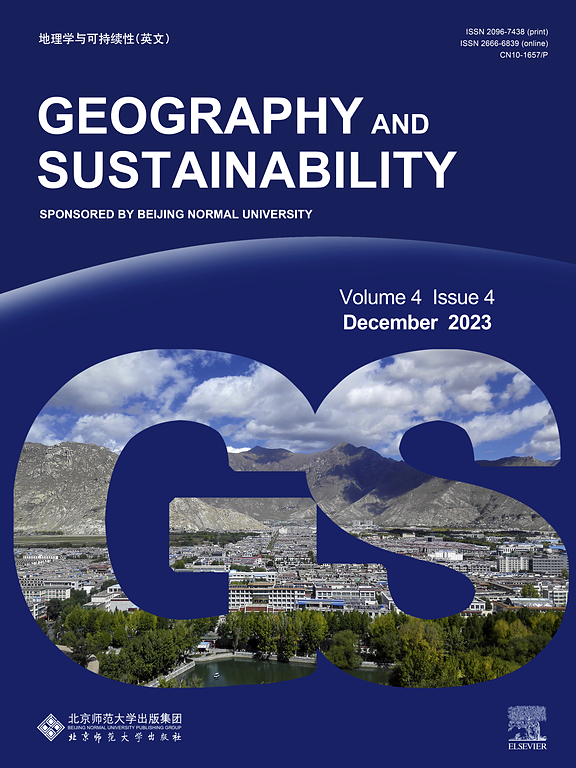Household farms facing barriers in indigenous knowledge-based adaptation to extreme climatic events — Evidence from the Huangshui Basin
IF 8
1区 环境科学与生态学
Q1 GEOGRAPHY, PHYSICAL
引用次数: 0
Abstract
Global warming has led to the frequent occurrence of extreme climatic events (ECEs) in the ecologically fragile Qinghai-Xizang Plateau. Rural households face strong barriers in adaption, and food production is seriously threatened. Current methods for increasing household adaptability take a holistic point of view, but do not accurately identify groups experiencing different adaptive barriers. To better identify different barriers, this paper examines natural, economic, cognitive, and technical barriers. A total of 17 indicators were selected to comprehensively evaluate the degree of barriers to crops adaptation in response to ECEs. Key factors were further analyzed to identify paths to break down the barriers. The results showed the following. (1) Natural barriers were present at the highest degree, economic barriers appear to be smallest, and the overall barriers were biased towards the lower quartile. 10.82 % of the households with the highest barriers. (2) 67.38 % of households report taking adaptive measures in crops production. The increase of the barriers leads to an increase and then a decrease in the possibility of adaptive behavior. (3) Addressing technical barriers is key to rapidly increasing household adaptive behavior in response to ECEs. The study provides recommendations for local governments to improve household adaptation behavior from two perspectives: short-term and long-term optimization pathways. This study can help governments quickly locate households with different classes of barriers, and propose more targeted adaptation policies. The ultimate goal is to ensure the sustainability of crops production and the well-being of households in northeastern part of the Qinghai-Xizang Plateau.

家庭农场在以本土知识为基础的适应极端气候事件方面面临障碍——来自湟水盆地的证据
全球变暖导致生态脆弱的青藏高原极端气候事件频繁发生。农户在适应方面面临较大障碍,粮食生产受到严重威胁。目前提高家庭适应能力的方法采取了整体的观点,但不能准确地识别经历不同适应障碍的群体。为了更好地识别不同的壁垒,本文考察了自然壁垒、经济壁垒、认知壁垒和技术壁垒。总共选择了17个指标来综合评价作物适应生态环境变化的障碍程度。进一步分析了关键因素,以确定打破障碍的途径。结果表明:(1)自然壁垒的存在程度最高,经济壁垒的存在程度最小,整体壁垒向低四分位数倾斜。壁垒最高的家庭占10.82%。(2) 67.38%的农户报告在作物生产中采取了适应性措施。障碍的增加导致适应性行为的可能性先增加后减少。(3)解决技术障碍是迅速提高家庭适应行为以应对经济、社会和经济变化的关键。本研究从短期优化路径和长期优化路径两个角度为地方政府改善家庭适应行为提供了建议。该研究可以帮助政府快速定位存在不同类型障碍的家庭,并提出更有针对性的适应政策。最终目标是确保青藏高原东北部作物生产的可持续性和家庭的福祉。
本文章由计算机程序翻译,如有差异,请以英文原文为准。
求助全文
约1分钟内获得全文
求助全文
来源期刊

Geography and Sustainability
Social Sciences-Geography, Planning and Development
CiteScore
16.70
自引率
3.10%
发文量
32
审稿时长
41 days
期刊介绍:
Geography and Sustainability serves as a central hub for interdisciplinary research and education aimed at promoting sustainable development from an integrated geography perspective. By bridging natural and human sciences, the journal fosters broader analysis and innovative thinking on global and regional sustainability issues.
Geography and Sustainability welcomes original, high-quality research articles, review articles, short communications, technical comments, perspective articles and editorials on the following themes:
Geographical Processes: Interactions with and between water, soil, atmosphere and the biosphere and their spatio-temporal variations;
Human-Environmental Systems: Interactions between humans and the environment, resilience of socio-ecological systems and vulnerability;
Ecosystem Services and Human Wellbeing: Ecosystem structure, processes, services and their linkages with human wellbeing;
Sustainable Development: Theory, practice and critical challenges in sustainable development.
 求助内容:
求助内容: 应助结果提醒方式:
应助结果提醒方式:


